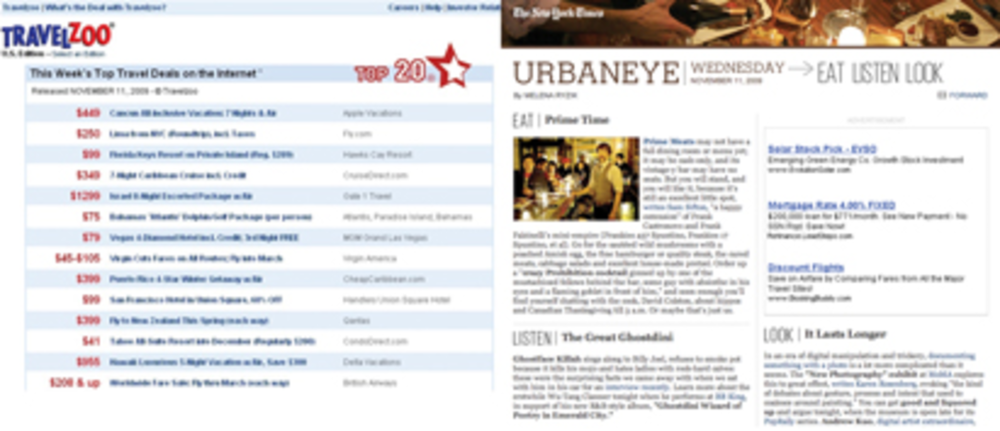The batch and blast approach to e-mail was embraced by early adopters — but eventually this tactic was outlawed. The channel has become more sophisticated, now allowing triggered messaging, transactional marketing messages and social media integration. E-mail marketing was groundbreaking in terms of measurement partly due to its shaky start.?
“The early version of e-mail analytics included real-time traffic of opens and clicks, which for people who were used to direct mail, was revolutionary,” says Andy Frawley, president of digital services at Epsilon. ?
When e-mail marketing began, it was all about building your list and renting lists from others.?
“I can remember working with big companies who had 1,000 people on their e-mail list, and that was a big deal,” Frawley recalls.?
While basic segmenting was a part of e-mail from the very beginning, it took a while for this to become commonplace.?
The next big trend to hit e-mail after segmentation was permission-based marketing, through which consumers could actually opt in to receive e-mails and, in some cases, set preferences as to when and how they’d like to be messaged to.?
“Permission has changed a lot,” Frawley notes. “Back in the 90s it was about learning how to actually deliver mail through the ISP.”?
One of the biggest drivers for permission based e-mail marketing was legislation. The CAN-SPAM Act was passed by Congress in 2003. It established the industry rules and regulations about sending e-mail, in an effort to prevent spam.?
One of the main rules is that marketers cannot e-mail people unless those consumers have opted in or have done business with the brand in the past. Also, the e-mails have to be clear that they are advertising messages and the sender has to be identifiable to the recipient.?
After these rules came out, e-mail began to grow more as a retention tool and less as an acquisition tool. Marketers stopped buying lists and began to focus on building relationships.?
“Now the lawyers were involved and there could be liability,” says David Daniels, analyst at Forrester Research.?
CAN-SPAM legislation also led to e-mail delivery specialty companies such as ReturnPath, Habeas and Goodmail to help senders monitor their behaviors and to liaison with the ISPs who provide feedback loops about a sender’s reputation. The industry standard is to use Microsoft’s sender policy framework and Yahoo’s Domain Keys authentication tool for big senders to prove legitimacy.?
E-mail delivery has also evolved to focus on sender reputation as the norm today, vs. the earlier renditions of avoiding “spammy” words in?subject lines — such as “FREE [product]” — to determine deliverability.?
In the middle of this decade, there were a number of acquisitions that consolidated e-mail vendors, as data companies saw the potential of owning marketing service firms. In 2004, Experian bought CheetahMail, in 2005 Epsilon purchased Bigfoot Interactive and in 2006, database company Datran Media acquired ESP Skylist.?
The reasons brands use e-mail have also evolved over the years. For The New York Times, which has used an e-mail program since the mid 1990s, the idea was to help build the brand. ?
“The initial reason behind having an e-mail product as a whole was to drive traffic,” says Mike Foley, product manager at NYTimes.com. “We didn’t think of it as a huge revenue machine. The concept was to get people to the site, to get them to be engaged and interested.”?
The paper began with a handful of e-mails?on general topics including news and books. Today, the Times offers about 20 different kinds of editorial newsletters.?
“Slowly we started to add additional titles and we realized that there was an opportunity to monetize those products,” says Foley.?
For Travelzoo, e-mail has been core to its business since it was launched in 1998. The company’s founding partners decided to build Travelzoo around a travel e-mail that features a roundup of travel deals online in its Top 20 e-mail newsletter. Since it began 11 years ago, the newsletter has added about 1 million subscribers a year, with more people joining in the last couple of years, bringing the list to 17 million subscribers. ?
Travelzoo’s model hasn’t changed dramatically since it began. “We have stayed focused on providing our subscribers with the highest possible quality travel deals in the e-mails,” says Craig Calder, VP of marketing at Travelzoo. ?
This kind of targeting is being seen across e-mail marketers, as customer data is being used more to inform campaigns.?
“American Airlines used to send e-mails of fare alerts without personalizing it to your home airport,” Daniels remarks. “But now they do. So if you live in New York, you will get deals from JFK and not from Dallas.”?
As e-mail continues to grow up, it is becoming further integrated with other channels. Social media and mobile have not killed e-mail; the growth of these channels is making e-mail viral. Many vendors today, including Experian, Lyris, Datran and StrongMail offer e-mail and social media integration tools.







